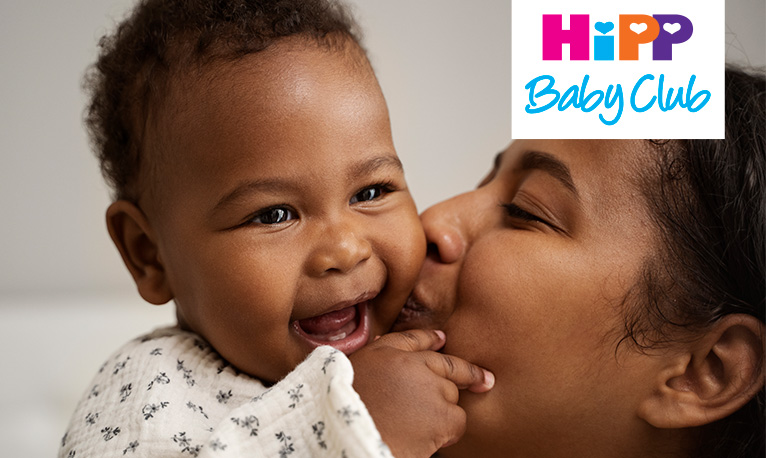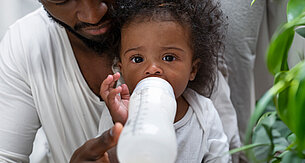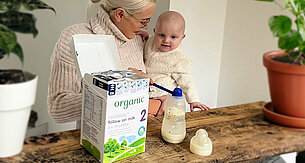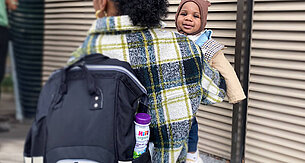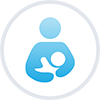How to bottle feed your baby
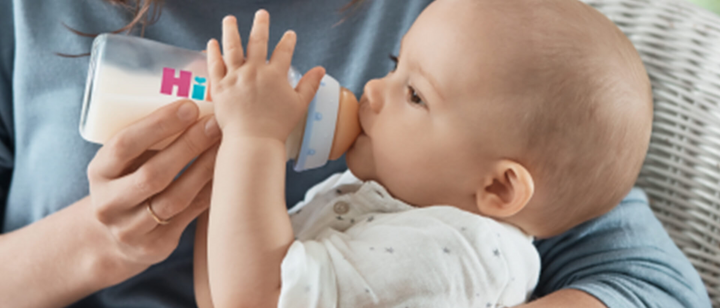
When your little one is hungry, they make sure you know it! So, making sure they have what they need is a real focus, especially in those early months of parenthood.
World Health Organisation guidance is that exclusive breastfeeding is best for your baby for the first 6 months of their life, and alongside food for a further two years and beyond. However, if breastfeeding is not possible or practical for you, you may consider combination feeding (i.e. breast and bottle-feeding, where the bottle-fed milk could be either breastmilk or milk formula), or exclusive bottle-feeding. This is your decision, but it is worth talking to your health professional before deciding to introduce a bottle, as there are implications (to your milk supply, body and finances!) should you decide to reduce or stop breastfeeding.
With breastfeeding, your body regulates your milk supply to meet your baby’s needs, which is why breastfeeding mums are always advised to feed on demand. However, if you decide to bottle feed your baby, you might be wondering how much and how often you should feed them.
How much milk does my baby need?
Bottle feeding can involve either formula or expressed breast milk and how much milk your baby will need will vary depending on their age and weight. Newborns generally only need a small amount but this will grow as they get older and bigger.
Most babies will fall into their own feeding pattern and routine and you should feed your baby when they show signs of being hungry. Don’t ignore your baby’s hunger cues to stick to a strict regime.
When your baby is first born, they will usually only take small amounts of milk by bottle, whether it is expressed breast milk or formula. Once they are a month old, they will probably need between 90 ml and 120 ml of milk for a feed. However, if you are breastfeeding this is obviously impossible to gauge so you can be guided by your baby’s wet and dirty nappies.
If you are formula feeding, most babies who are more than a week old will need between 150 ml and 200 ml per kilogram of their body weight over a 24-hour period, until they are around 6 months old. This means a baby which weighs 5 kg or 11 lbs will need between 750 ml and 1 litre of formula milk per day. How much formula they will need will depend on how heavy they are and, of course, all babies are different and some will have bigger appetites than others.
You may find there are times when your baby wants to bottle feed more often than usual. This might be because they are teething or feeling unwell or they may be experiencing a growth spurt.
How often does my baby need to feed?
Newborn babies need to feed little and often and will usually need to be fed every two to three hours. Let your baby lead the way and allow them to feed for as long as they want to.
If they start to refuse the bottle, stop the feed. Don’t try to force your baby to continue feeding until they finish the bottle.
As your baby gets older, they will start to go longer between feeds and you may find you only need to give a bottle every four hours.
As a general guide, a newborn baby may typically take around 60 ml to 70 ml of formula per feed seven or eight times a day. Between three weeks and eight weeks, they may take between 90 ml and 120 ml five to seven times a day.
Between two months and six months, a bottle-fed baby may only need around five feeds a day but will take more milk at each feed – between 150 ml to 210 ml.
Babies who are older than six months still need plenty of milk alongside solid foods. They are likely to only need four bottle feeds a day at this stage with between 150 ml and 180 ml per bottle. This will gradually decrease as they start to eat more solid food.
How do I know my baby is getting enough milk?
When you are bottle feeding you can measure how much milk they take at each feed. However, you still may be wondering if they are getting enough.
If your baby is settling in between feeds and gaining weight, this is usually a good sign that they are feeding well. Another indicator is how many wet and dirty nappies they are producing.
Once your baby is a few days old or older, they should be producing at least six wet nappies in a 24-hour period. For the first 48 hours, this will be less and only two or three wet nappies is normal.
For the first week, you can expect your baby to have four dirty nappies a day. As your baby gets older, the number of poos they do each day will decrease and may go down to two a day after a few months.
If you need more individual advice on how much or how often to feed your baby, please contact your healthcare professional.
How to spot hunger cues
Just as with breastfeeding, it is important for parents who are bottle feeding to learn to recognise when their baby is hungry. Crying is a late sign for hunger and there are plenty of signs to look out for before your baby gets to that point.
If your baby seems restless and is finding it hard to settle, this is often a sign they are hungry. You may notice they are turning their head and opening their mouth – an instinctive action which is known as rooting. You may also find that your baby is sucking either their fist or fingers or is attempting to suck something else like a toy.

